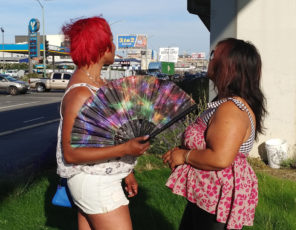
Audio Player
A couple months ago, KPFA brought you a documentary on day to day life in a homeless community in Oakland near Home Depot in Fruitvale called The Community of Grace. That was a community that was more or less self-organized: the people there set rules, enforced them, chose who to let move in, and who to turn away.
Now, the city’s announced it intends to close that area and evict the people living there. So we decided to explore the story of what happens when unhoused people get evicted. And that meant telling the story of a different encampment, one that didn’t get to organize itself, because it consisted of people flooding in from other evictions. Reporter Lucy Kang got to know three women living there, and followed them through what came next.
The first time I meet Mouangjoi Tracy Saelee, it’s in January, on a muddy strip of land at the intersection of Oakland’s East 12th Street and 23rd Avenue. We’re between an overpass and elevated BART train tracks, two miles from downtown, on a street lined with auto shops. The land is covered in tents, tiny houses, and trash. And Tracy’s outside, looking into a mirror, putting on an enormous eyelash extension.
“When I became homeless, everybody became homeless,” says Tracy. “I was like the block haven, you know. Anybody could come through over to my house to take a shower, when you’re hungry. You feel me? My door’s always open to everybody, anybody.”
“She lost her place and came and stayed with me,” says Morgan, who’s not using her real name. She’s got short hair dyed bright, bright red to the roots. And she waves this big fan when she talks. When she gets worked up, she taps it to make a point. She and Tracy have been taking care of each other for a long time.
“And then I lost my place and turned around came to stay with her,” says Morgan.
“When I became homeless, everybody became homeless.”
Eventually both of them lost their places. I didn’t press for details on how. But they didn’t have anywhere to go but the street. Tracy points at all the places she camped before.
“And then I moved over there, over there,” says Tracy.
“No, no, we went to Burger King, across the street from the Burger King,” says Morgan.
Their last move came when the city was evicting homeless encampments across Oakland around the end of 2017. City workers drove their stuff to the plot where I found Tracy putting on eyelashes – that muddy patch of land between an overpass and BART train tracks.
“We did encourage them to move down to East 12th and 23rd,” says Joe Devries, Assistant to the City Administrator. He’s basically the go-to person in city management who deals with homeless encampments. Whenever the city evicts one, he’s usually the person giving interviews.
“You know, the reason we thought that the flat parcel made more sense,” he says, “was a), it was flat, b) it was big, there was room, and c) we were putting in porta potties and wash stations. This was right when the city was first putting out porta-potties, wash stations, you know, weekly garbage service.”
The city had also promised this land to an unhoused community called the Village. The Village needed a new place because the city evicted them from Marcus Garvey Park in February 2017. Anita de Asis Miralle, who goes by Needa Bee, co-founded The Village.
“City council created a recommendation that actually for the mayor and her administration to give us land, which they didn’t want to do,” she says. “And that came out of them bulldozing our first Village, very successful Village.”
She was planning to re-establish it here – until she found out how many other people the city was sending over.
“So he took six encampments from across Oakland from… 16th Ave to like 82nd Ave,” she says. “And when we showed up there were like 47 new people there and have taken up the whole plot of land.”
The city disputes this. Joe DeVries says the city did move people to East 12th and 23rd, but from only one encampment: the one where Tracy and Morgan were staying.
“Some of the public works supervisors said, yeah, we can help them move stuff down on our flatbed,” he says. “Some have argued that they were told to move there by the police, and I have not been able to track down any source of that.”
Tracy remembers having to move that day.
“One day the city dump truck came over and said that, feel me, we have to move them there or they’re going to throw all our [expletive] away,” she says. “And then the people that can’t move the stuff, they’re gonna get thrown away or whatever. So it was like, oh my God, no one can help us move. And they said ok, fine, we’ll help you guys move… They put all our [expletive] in the dump truck, were literally put on a dump truck, came here and dumped us out here.”
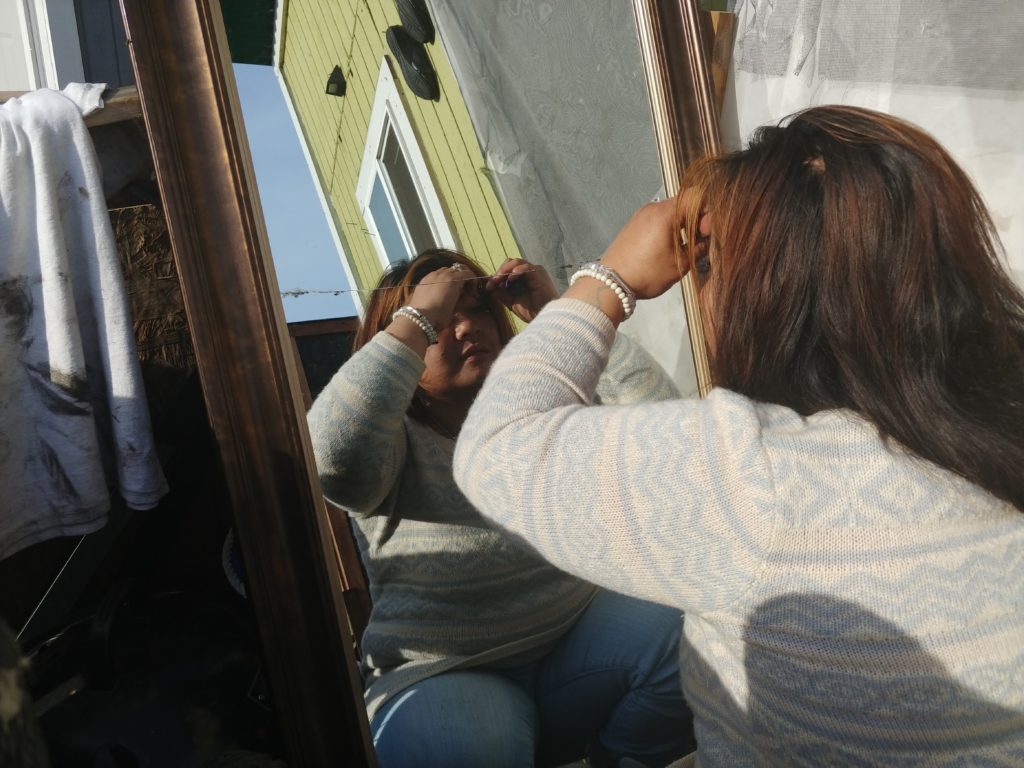
“Crisis upon crisis”
The rush of new people derailed Needa’s plan for a new Village.
“We had different neighborhoods and different… family rivals, all in one piece of land,” she says. “And we were set up to deal with crisis upon crisis upon crisis.”
Even though Needa didn’t feel like she could stay here, the Village did eventually build six tiny houses. She and Tracy gave this place a new name.
“Me and Needa named it the Two Three Hundred Ohlone Village,” says Tracy, “because this is Ohlone land, you feel me.”
(The Ohlone people are the original indigenous inhabitants of the Bay Area.)
There were lots of problems at East 12th and 23rd.
“This is not even human,” she says. “I mean, this is not even an animal living standards, I don’t think, cause I won’t even want my dogs live out here. Seriously. Look at this place. This is a dump.”
The day we did this interview, the ground was muddy and full of things like discarded clothes, broken furniture, trash bags and tires. It’s not clear how much was people’s possessions and how much was garbage. But there was a lot of stuff.

The third person I followed was Kimberly Medrano. She’s a bit older than the two and used to work in warehouses, until a brutal dog attack injured her permanently.
“I got holes all all up in here,” she says. “You can see some scars.”
When I spoke to her, Kimberly estimated there were a hundred people living on the muddy strip of land at East 12th and 23rd, way too many for the city’s limited trash service.
“And you’re only going to only allow the trash to be picked up twice a week,” she says. “You won’t let us have garbage cans or dumpsters to put it in. So we’re just throwing it on the ground. The rat population is crazy.”
Almost everyone mentioned the rats.
“You know, there was a guy out here,” she says, “with some kind of firearm shooting the rats, running around screaming, shooting the rats. And I think only once he got one.”
So there’s the problem with the trash and the rats. Then, there’s the toilets. Officially the city provides porta-potties. But the contractor didn’t clean them on schedule. And they overflowed.
“What I do is crap in a bag and get rid of the bag,” says Kimberly. “Or I use a bucket and then pour the pee out.”
Then, there were fires.
“Fires there all the time,” says Kimberly. “Every other day there was some kind of fire. There’s been major fires over there, people know.”
Then, there were deaths.
“Five deaths that happened here, feel me, that ever since I’ve been here, five people have died,” says Tracy. “On this ground. Because of natural causes, or they claim it natural causes. But I don’t think so. I think it’s because of, because of them being outside and so cold they get sick, you know.”
Needa Bee blames the city.
“People were literally, literally living on top of each other because there wasn’t enough room,” says Needa. “We actually blame, we blame the city for the murders that happened on that land. We blame the city for the rapes that happened on that land. We blame the city for the fires that happened on that land. Because folks there should have never been dumped there and been forced to live on top of each other.”
Still, Kimberly carved out a home. She lived in a wooden structure with a smaller tent inside for a bedroom. She had a propane stove for heat. She got her water from a nearby spigot.
“And I would heat a little bit on the stove,” she says. “And I’d have my bowl. And I have my mirror right there. And you know, I’d wash my face and brush my teeth and whatever I needed to do.”
She even had a bathtub.
“Take a bath sometimes, full bath,” she says. “And yeah, I was self-sufficient. I was very self-sufficient, which I liked. I like being self-sufficient. I never borrowed anything from anybody over there. I never ran out of batteries for my lights or my flashlight.”
Kimberly actually thinks she was one of the lucky ones.
“Like I said, I’m just grateful that nothing really bad happened to me,” she says. “I was in a good corner. Let’s put it that way, in a good corner. But if there was a fire, I was screwed because I had behind me I had two fences… But I was in a spot where really bad things didn’t happen to me. Like I didn’t get raped or any of that. Thank God.”
Rape came up with a lot of the people I spoke to. What research there is shows that women sleeping on the streets are raped more frequently than housed women. Clearly, it is something they think about a lot.
So to sum up: there were people living at different encampments across Oakland. The city evicts them. Many move here to East 12th and 23rd. Horrible conditions result. So what does the city do next? Another eviction.
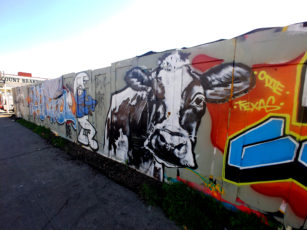
Evicted again
After the city promised the land to the Village, it ran into a problem.
“It was literally the same week that we found out from the Department of Transportation that that was not going to work,” says Oakland’s Joe DeVries. “Our Department of Transportation team told us the construction project for the… 23rd Avenue Bridge is ready to move forward in about a year. That site has to be cleared.”
The project was a seismic retrofit on the overpass that flanked one side of the encampment.
So the already-displaced residents of East 12th and 23rd had to move again. I visited in January, when the eviction was imminent. Some had already left. Others were packing up.
“I don’t know,” says Kimberly. “It’s scary. I just woke up from having a bad dream that they try to transfer us from there to some place. It was along a highway somewhere out in the boonies. And then one of the ladies admitted to me that that’s what they’re gonna do. That they’re going to decide who they were going to keep and who they’re going to dispose of. And that’s what kind of dreams I have.”
To prepare for the eviction, the city built a site on nearby Miller Avenue with Tuff Sheds. They’re meant to be emergency shelter. City officials call them “Community Cabins.” Joe DeVries gave me a tour the day the site opened.
“I’m gonna shut the door just to show that they’re not they’re not tool sheds,” he says.
They may not be tool sheds, but they’re not exactly housing. One, they don’t have full electricity. They’re fitted with only USB charging ports.
“They don’t have full electrical in part due to just cost and due to safety,” he says.
Two, they don’t have plumbing.
“We have porta-potties here,” he says. “I think there’s another set over there. They’re, they’re cleaned I think four times a week. We do have an endless water supply for people for drinking water. We don’t have running water at the site… That’s a heavy lift from a contracting point of view, from a construction point of view.”
Three, they don’t have heating.
“There’s batts of insulation underneath here,” he points out. “And people would be supplied with you know, blankets and pillows and things like that.”
The walls are covered in white plastic sheeting. Right now there’s just a pair of bare folding cots.
Here’s how it’s supposed to work: the city sets up Tuff Sheds near encampments they plan to close. The encampment residents move in. They’re meant to stay no more than six months. Meanwhile the city tries to connect them to housing and other services.
But, this is the same city that has previously evicted many of the people they hope to move here. And the city hasn’t exactly earned their trust.
“It was horrific”
On eviction day at East 12th and 23rd, there are still a lot of people who haven’t moved to the sheds. Tracy is on the street looking distraught. One of her eyelashes is coming off.
“I don’t have nowhere to sleep, you know,” she says, “and I’m just staying up. Hopefully I’ll probably take a power nap or something before I go to work or whatever, you know. But as for now, I don’t have anywhere to live.”
The eviction took days. Kimberly’s place got bulldozed on day one.
“It was pouring rain,” she says. “It was really muddy. It was slippery. There was garbage everywhere, people’s stuff in the way, the yellow tape… There was so many police officers and mostly police officers and public works people. It was ridiculous. I mean I had to go around them… So everything was broken in the street and everything, nobody’s helping us with traffic. But they’re demanding that we get everything over there.”
Needa Bee was also there. “It was horrific,” she says. “I feel so bad. Like I don’t know why I’m being emotional right now. It was horrific. People started packing and took the beginning of their belongings across the street, like a duffel bag or a box. And then turned around to go back and continue moving. And the caution tape was already up and the bulldozers were already bulldozing people’s tents. So people were screaming and crying. And it was horrific… People were getting hysterical. They were actually watching their stuff getting crushed. Like there was a lady there who is a is a musician. They crushed her violin. They crushed her drum set… People lost bikes. One lady lost all her uniforms for work. And then lost her job because she showed up at work with no [expletive]-ing uniform.”
Assistant city administrator Joe DeVries says city workers tagged people’s belongings and moved them in accordance with city policy.
“So you’ll see things getting scooped up today where you might think, oh, no, they’re taking some of the stuff,” he says. “We’ve gotten approval from individuals beforehand to remove that stuff. So they leave a lot behind.”
To recap: the city of Oakland evicted Tracy and Morgan from their encampments. It moved them to East 12th and 23rd. Then, it evicted them, again.
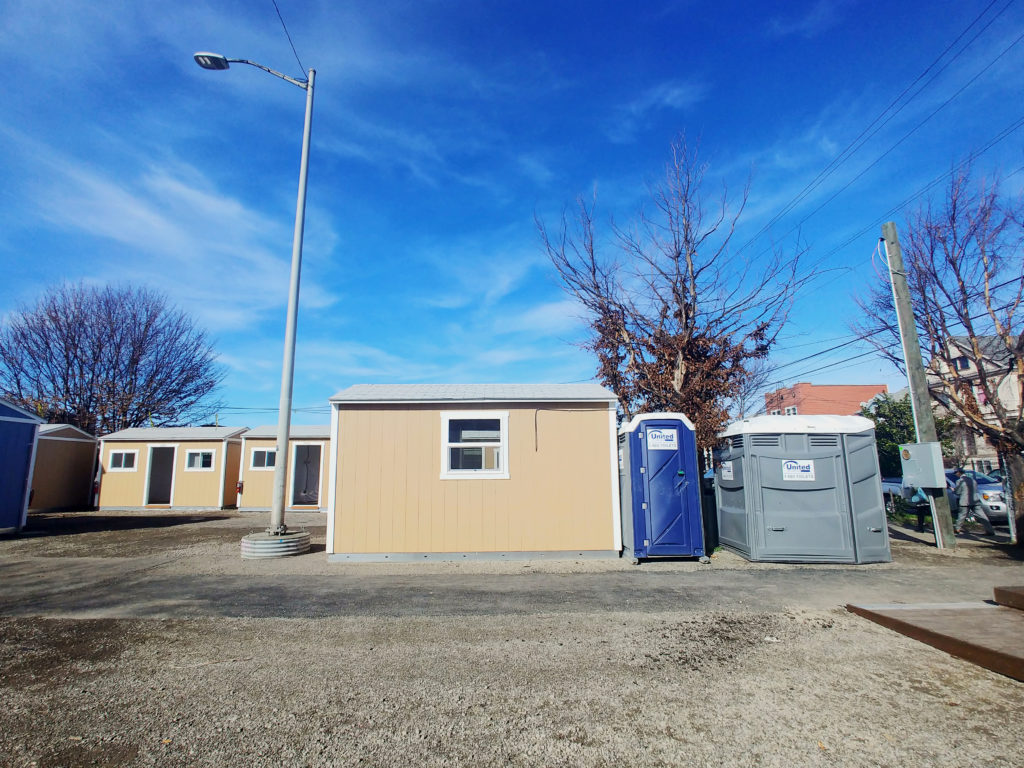
The Miller Avenue Tuff Sheds
At the time of the eviction at East 12th and 23rd, the city claimed they had nearly enough space for everyone at the Miller Avenue Tuff Shed site.
“We found 39 people,” said Joe DeVries on eviction day. “We have space for, well, 38 people here.”
Almost everyone we spoke to getting evicted from the encampment wanted to move into the Tuff Sheds. But they also said the city’s count was low, which turned out to be true.
Four months after the eviction, Joe DeVries also acknowledges this.
“There were more people at the site than originally were there when we did the census,” he says. “It was really hard to figure out who actually lived there, who didn’t.”
I ask if that meant that there weren’t enough spots at the Miller Tuff Sheds to accommodate all the people in the encampment.
“Well it does mean that,” he says. “But we don’t have enough spots to accommodate the homeless in Oakland in emergency shelter right now. I mean that’s, that’s absolutely true. We couldn’t build a bigger site. If you’ve been to the Miller site, it’s tight, you know. It’s an effective location, but it’s certainly not big enough to meet the needs of the unsheltered in that part of Oakland. The hope is that we can move people out of there and into housing so that we can invite more people in.”
So the city evicted more people than it could shelter in the Tuff Sheds. That means it forced a lot of people from the encampment – to the sidewalks.
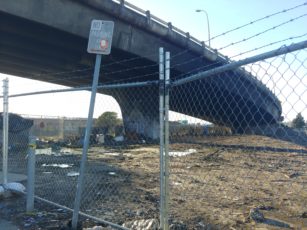
We’re going to follow people who did get into the Tuff Sheds. Here’s Kimberly.
“My personal belief is that, I know we couldn’t stay there,” she says, meaning the old encampment. “But I was better off there. And the only thing that’s like really better is the fact that the rat problem was so bad.”
Tracy and Morgan also got into the sheds. They all had to agree to rules: no weapons, no violence, no public drug use. Leave for more than 72 hours, you lose your spot. And no burners or open flames.
“Well, come to find out we’re not able to cook here at all,” says Kimberly. “So it’s hard. I’m used to cooking. Oh, we’re starving, you know, and then we’re at the mercy of whatever they cook for breakfast, which they don’t really cook anything for breakfast, just one day maybe they heat something up. But you’re at their mercy, you have to be here at certain times to eat. And sometimes, I mean I was getting stomach-aches, and I was like, okay, I’m not eating that.”
The site does have a microwave and toaster oven to heat food. But that didn’t work for everyone.
“Why weren’t they able to afford us to have a breakfast, lunch, dinner, snacks or even a kitchen there?” asks Morgan. “Oh, I forgot it’s because they said that we had too many fires.”
I asked if they didn’t provide enough food.
“They gave us breakfast and dinner,” says Morgan.
“Our breakfast was like bread,” adds Tracy
“Bread and oranges,” says Morgan.
Then, there was the cold.
“I’m freezing my [expletive] off,” says Kimberly, “because I’m allergic to the wool blankets they gave us. And they, the structures are so cold. I’m not blaming Roots [the nonprofit running this site for the city] like, but I’m freaking freezing. And then I was told by one of the staff members whose not as seasoned, he’s kind of new… He said well, if you’re allergic to the wool blankets then you’re going to have to buy some. With what money?”
The night before I spoke to Kimberly, the temperature had dropped to 36 degrees. This was February. Five months later in July, the city still hasn’t finalized a cold weather protocol.
So there were food problems. And there were weather problems. There were also roommate problems. The Tuff Sheds are double occupancy. Everyone had to find roommates.
“I’m right now looking for the girl I’m supposed to room with because you have to have a have somebody,” said Kimberly, shortly before moving in, when the city was getting ready to evict everyone. “And she’s at least of the evils. So I had picked her because I already knew her.”
Tracy was also looking for a roommate.
“And there’s a girl here that’s going to have a place but she doesn’t have a roommate,” she says. “So I’m going to, might have to share with her. I don’t like her, feel me, cause we don’t get along. She just, she’s her, you know. And I’m me.”
So you take a bunch of people who are living without structure. And you put them in a place with a lot of rules. You take people who’ve survived on the streets by being fiercely independent, and in some cases make them bunk with strangers, in 15 by 8-foot sheds.
Morgan knew her roommate – she picked him – but their relationship went bad while they were living together.
“Well, I told them, I need you to move my roommate,” she says, referring to the staff who run the Tuff shed sites, including housing case managers called navigators. “And I told them this for about like two months. They wouldn’t do it… I told them, look, I’ll move. I don’t care. They can stay here. Just let me, let me out of here because it’s getting real bad. And they still didn’t move me.”
Her roommate had threatened her.
“The first time my roommate was saying bitch, I don’t give a [expletive],” she says. “I don’t care about these this security or whatever the [expletive] they think they are. I’ll slap the [expletive] out of you.”
She says a navigator watched this exchange.
“And the same guy turned his back and walked away,” she says.
Morgan doesn’t remember that navigator’s name, so I couldn’t get his side of what happened. Everything you’re about to hear is according to Morgan, who says her roommate problems kept escalating.
“We got into it pretty bad,” she says. “And we were just kind of, actually, I was exchanging a lot of words. And then my roommate wanted to come in. And I told the navigator, no because we’re getting into it. And they’re like, well, that’s your –”
“And you weren’t even dressed,” says Tracy.
“Oh yeah, and I didn’t have any clothes on,” says Morgan. “And I was like, you know, I don’t have any clothes on, you know, he can’t come in. And he was like, well, you know, he lives there with you. So what? That’s my roommate. You know what I mean? And so he was like, I’m gonna open up the door anyway.”
So again, Morgan’s inside her Tuff Shed, undressed. She’s fighting with her roommate who’s on the outside. And this staffer, a navigator, unlocks the door.
“And so I was holding the door so he couldn’t unlock it. And like with my toe, I grab my outfit and like drug it towards me. And pulled it on because I was bathing. And as soon as I pulled it up and let go of the, like I had to let go of the doorknob, and I pulled it up, he unlocked the door. And the first thing my roommate did was grabbed onto me threw me down. And the navigator looked turned his back and walked away.”
Just to be clear: throwing someone to the ground is assault.
“When my roommate threw me on the ground,” says Morgan, “I slipped and stepped in some glass. Like there’s blood, bloody footprints on the floor, you know, and like we got into it pretty bad. The navigator never made a report. He didn’t call the police. He didn’t do anything –”
“Didn’t call the paramedics,” says Tracy.
“So I just I left,” continues Morgan.
Like I said, this is Morgan’s story. I didn’t get to speak to the navigator or her roommate. But the point is she was in a bad roommate situation. Things got violent. And the people running the Tuff Shed site didn’t have anywhere for her to go, but back onto the street.
I asked the city about allegations of violence and staff’s failure to respond to it here. Lara Tannenbaum of Oakland Human Services says she didn’t know about specific incidences. This is from the email I got back from her:
“It is extremely unlikely that staff would not respond to violence or wouldn’t assist an injured client. Staff at Miller Ave take the safety of the site very seriously.”
In Morgan’s story, she was the one who needed assistance. Instead, she got evicted.
“I came there the next day and –” she says.
“They didn’t even let you in,” says Tracy.
“And I was like, well, can I get some of my clothes?” says Morgan. “And they’re like no you have to come back tomorrow.”
Morgan says that’s how she found out she was evicted. No warning, no notice. She just got turned away at the gate. Oakland’s Lara Tannenbaum said that residents are supposed to get written notices and a chance to contest them. But Morgan says there was nothing.
“They threw my things away without even like warning me, you know,” she says. “And people are walking around with my clothes on.”
Oakland’s Joe DeVries says Tuff Shed evictions are not common.
“You know right now for all of our cabins about 71%, it changes every week, exit to housing,” he says. “But there is that 30% or 29% that doesn’t exit to housing. About it’s half abandon the program and about half are kicked out of the program for violating the rules. And so 15% kicked out. 15% choose to leave. 70% find housing.”
He’s talking about the combined data from all the Tuff Shed sites, citywide. But the figure for just the Miller Avenue site is much, much lower. According to figures the city sent me, as of July 8th, only 21% of people who had left the site exited into housing. Of the remaining 79%, more than half were evicted. The city maintains that that people are only asked to leave the Tuff Shed sites for breaking the rules about weapons, violence, and illegal activity. But Needa Bee says there’s a problem with due process around evictions.
“A bunch of folks got housing at the Miller Avenue site,” she says. “And within the first month about twelve people got evicted with no process, no reasons. Everyone who got evicted, and it turns out that this is happening at all the Tuff Shed sites. Once they’re evicted, they can’t even get their property back… And they’re back out on the streets.”
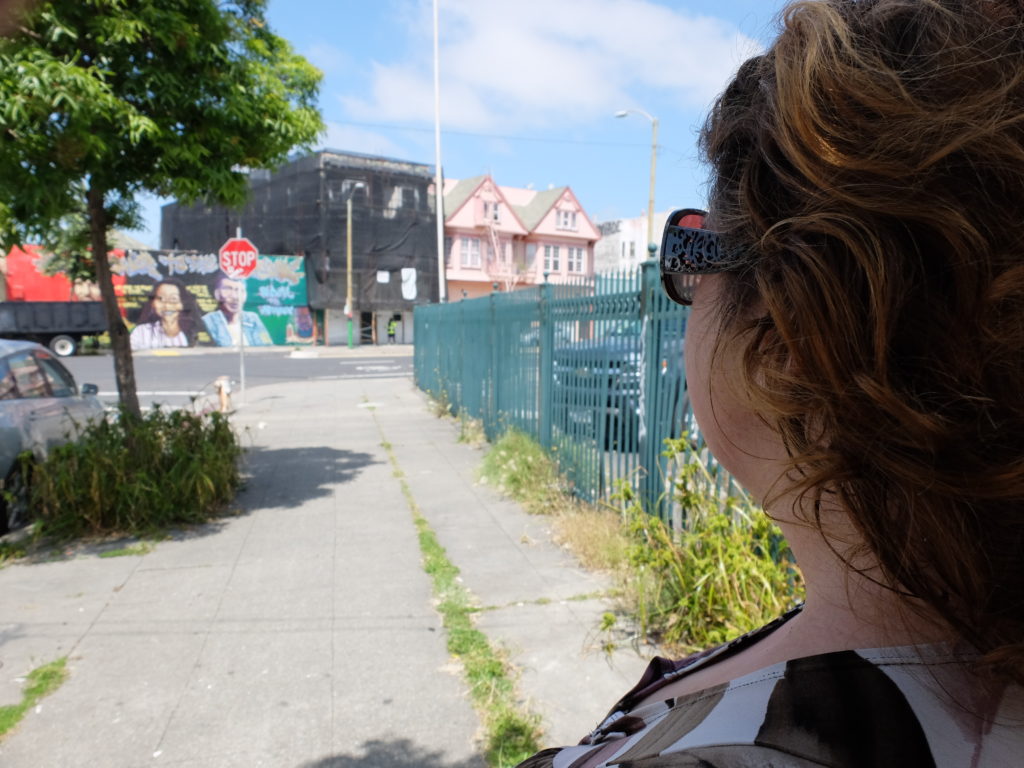
Four months later
Here’s where everyone is in June, four months after the eviction at East 12th and 23rd. Kimberly is housed in Oakland.
“So anyways it’s the bottom story of this Victorian,” she says. “There are five bedrooms, and I have four roommates. There’s all brand-new appliances in there, including a brand-new washer and dryer.”
Kimberly got housing through a program for people over 50 with health problems. It’s run by Kaiser Permanente and Bay Area Community Services, or BACS. The program pays for most of her rent.
“I only pay a third of my income, which I’m on GA, 336, she says. “So that’s I pay a hundred dollars and eighty cents a month for the next year for rent.”
Next seven months, actually. The program, which is called the Kaiser-BACS Older Adult Initiative, is only funded through next February. For now, she’s housed. I ask her how her day-to-day life has changed.
“Well basically I’m getting some sleep,” she laughs, “which I wasn’t getting with the roommate I had in the Tuff Sheds and the chaos… It’s a lot more quiet. It’s nice to be able to take a hot shower every day if I want to, you know. Just being able to heat up food, refrigerate food. I can wash and dry my clothes, we have a washer and dryer.”
I should point out though: she doesn’t think the Tuff Sheds program is what got her housed. She says she got connected with BACS outside of the program.
And there are two problems on the horizon. One is, the rent subsidy won’t last forever. When it’s gone, Kimberly’s rent goes up to more than twice her income. The other is roommates. Recently she confronted one about leaving a pot on the stove.
“And I came out of my bedroom and the pot was already burnt,” she says. “But it was ready to catch on fire. And then by the time we got him awake in his room, he started yelling at me and yelling at me and saying it’s his pot… It’s a challenge. It’s a challenge cause you’re dealing with your own things, you know, your own inner turmoil, you know, your own outer turmoil.”
Kimberly has PTSD related to fire.
“And then you’re like forced into a closed circumstance with somebody else that has theirs,” she continues. “And theirs might be a lot different, a lot worse than yours and it’s like a tornado. You just got to try not to get swept up.”
In fact, Kimberly says she might move out early because of the roommate problems. She’s hoping for a settlement from a disability benefits case. If she gets enough, she wants to buy a trailer.
“It’s like a little home,” she says, “and it would be mine.”
That way, she says, she won’t fear being displaced ever again.
Tracy and Morgan went from the Tuff Sheds back to the street.
“Actually, it’s gotten worse,” says Tracy, “because now that we have nowhere to go and we have no hopes or anything to look forward to because at least over there they told us they had a place for us, you know… And then when they put us in a Tuff Shed, they just evicted us without notice… Like, where are we supposed to go? We’re not going to I mean, I don’t want to go back over there to East 16th cause it’s like the same [expletive] over again, you know… Like you evict, you guys evicted us off of there and you guys telling us to go back over there so that you guys can evict us again?”
By East 16th, she means the place Oakland evicted her from, before it moved her to East 12th and 23rd, which is the place Oakland evicted her from to get her into the Tuff Shed, which is the place Oakland evicted her from, to get her to where she is now, which is back on the same street she’s been already been evicted from at least twice.
I ask Morgan and Tracy what the impact of constantly having to move is on their personal lives.
“Severe anxiety and depression disorder,” says Morgan.
“Right?” agrees Tracy. “And as I the same time is I mean it like just, just being afraid of just having anything, you know, because you’re going to lose it anyways. When I was at the Tuff Sheds I started, you know, collecting all my stuff, like I was buying things up. And then when they put me out, I brought it here. People stole all my [expletive] again. I don’t even have nothing, not even a memory of anything anymore because they really just took everything this time.”
“They’re here to help, but it just seems like they were here to harm,” says Morgan.
“For our situation, they made it worse,” says Tracy.
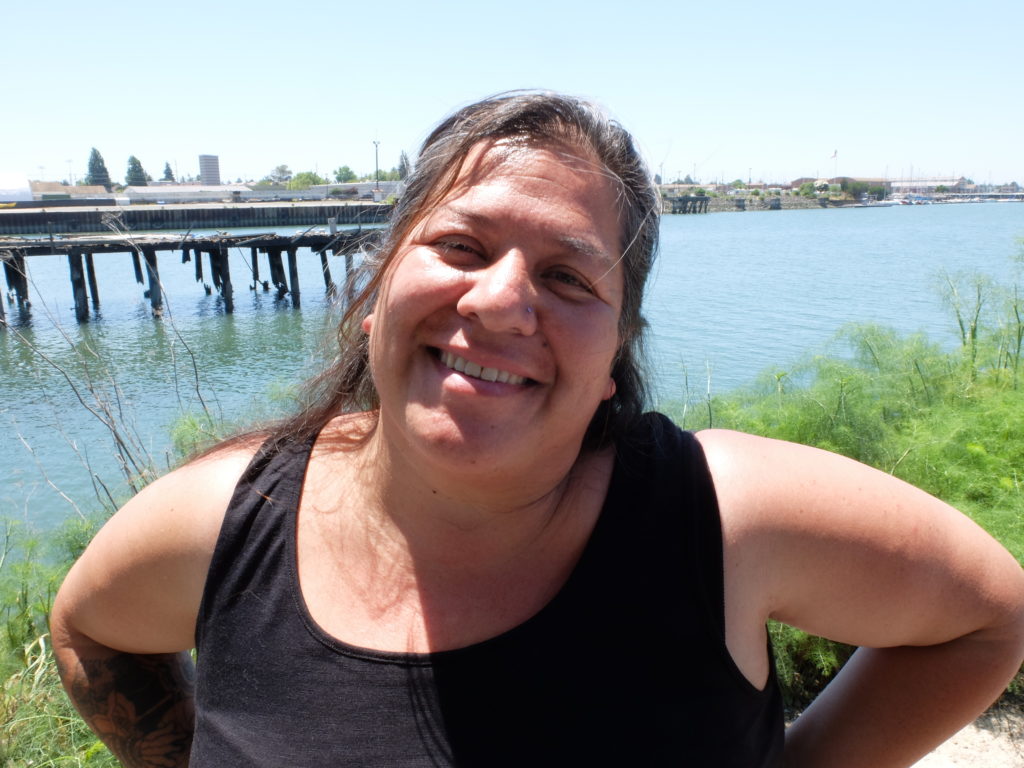
Needa Bee is documenting the cycles of displacement that unhoused people face in Oakland. I met her at Union Point Park where she was gathering declarations in support of a lawsuit against the city.
“Now we have all these declarations of people who have had first-hand repeated, if you look through the declarations, people have been evicted by the city five, six, seven times in the past year or two,” she says.
There are currently three active federal lawsuits against Oakland from residents of unhoused encampments who describe multiple displacements and evictions.
“It’s the same story,” says Needa. “It’s the same [expletive]-ing story.”
Online, the city posts what it calls its encampment cleanup schedule. Right now over a quarter of the posted evictions are labeled “enforcement of prior closure.” That means they’re re-evicting people from places the city has already done evictions.
Lucy Kang is a reporter for KPFA. Reporting help from Brian Edwards-Tiekert and Justin Gold. Thanks also to local blogger Jaime Omar Yassin for getting some of the documents I used into the public record.

